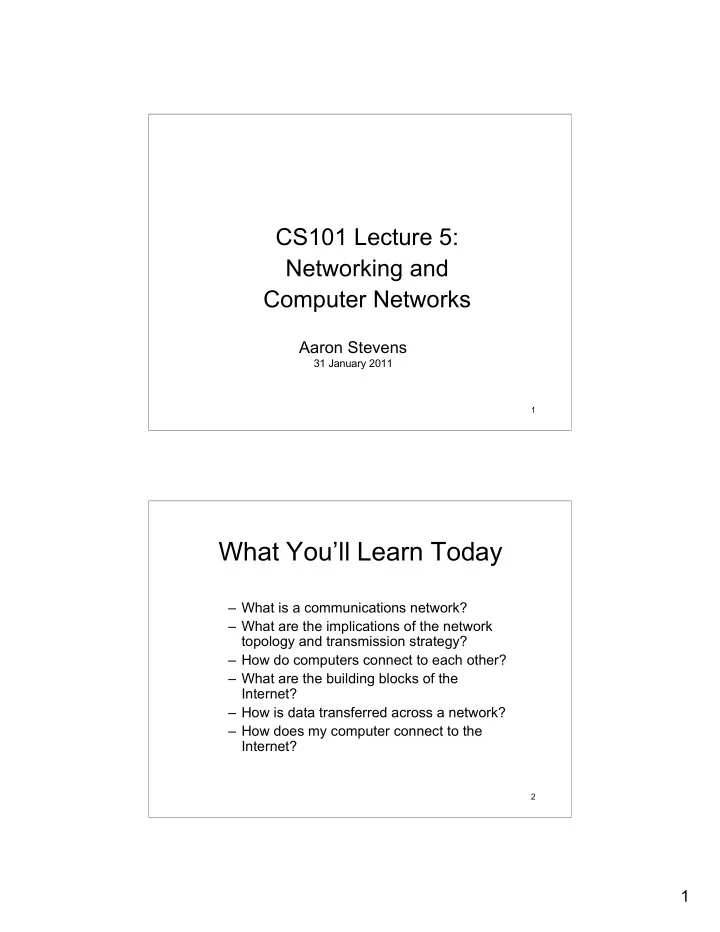

CS101 Lecture 5: Networking and Computer Networks Aaron Stevens 31 January 2011 1 What You’ll Learn Today – What is a communications network? – What are the implications of the network topology and transmission strategy? – How do computers connect to each other? – What are the building blocks of the Internet? – How is data transferred across a network? – How does my computer connect to the Internet? 2 1
Communications Networks – What is a network? What are its defining characteristics? 3 The Telephone Network POTS (the plain old telephone system), a.k.a PSTN To connect a phone call, the caller’s phone must be physically connected to connect to the receiver’s phone. Connecting these circuits (called switching) takes place at dedicated facilities called central offices. 2
POTS Circuit Switching Telephone wires leave your house, and connect to the central office. Image from www.exegesis.uklinux. net. At the central office, connections are made to other telephone lines… 5 POTS Circuit Switching Telephone operators used to actually switch wires to connect the calls. In the PSTN, this connection (called switching) is done electronically. 6 3
Modem Early computer networking used the phone network: dial up. A modem converts computer signals into sounds. 7 Circuit Switched Network Computers can be connected over a circuit switched network (e.g. phone lines), creating a circuit between the source and destination. Image from www.tcpipguide.com. A Switched Circuit connects devices A and B. 4
Circuit Switching: Details – How many circuits do you need to connect 1 pair of computers? 2 pairs? N pairs? – What happens when a backhoe cuts the line? 9 Bursty Data Transmissions Computers send data in irregular bursts. Example: email. Using a switched network connection is wasteful – the circuits must be connected even if no data is being sent! 5
Packet Switching Packet A unit of data sent across a network. Packet switching Messages are divided into fixed-sized, numbered packets. Packets are individually routed to their destination. Reassembled into messages. Router A network device that directs a packet between networks toward its final destination. Packet Switching Network Nodes send packets of data along routes to a destination, without a dedicated circuit. Packets (even in the same transmission) can take different routes. Image from www.tcpipguide.com. Image from http://www.teach-ict.com/technology_explained/packet_switching/packet.switching.gif 12 6
Packet Switching: Details – What happens to packets when they arrive? – Are they ready for consumption? – What happens if some packet(s) get lost? 13 What’s So Great about packet switching? –Efficient use of wires/circuits –Multiple paths between source and destination –Slow growth of network infrastructure as number of users increases 14 7
What’s Not To Love about Packet Switching? –Time required to reassembly messages, resend missing packets. • Why does this matter? –Speed of delivery: latency is not guaranteed. –Inefficient for small packets 15 Circuit or Packet Switching? – For which kind of information is circuit switching preferred? – For which kinds of information is packet switching preferred? – Are all packets treated the same by the network? Should some be prioritized? 16 8
Network Interface Controller Each node has a network interface controller (NIC) connected to its circuit board. The CPU treats the NIC as an input/output device. It communicates by reading or writing bytes of data to the NIC. Each NIC has a unique Media Access Control (MAC) address, which distinguishes it from all other NICs. 17 Types of Networks Local-area Network (LAN) A network that connects a relatively small number of machines in a relatively close geographical area. Wide-area network (WAN) A network that connects local-area networks over a potentially large geographic distance. Gateway/Router A particular computer on a LAN which directs all communication going between that LAN and other networks. 18 9
LAN/WAN Example LANs separated by a great distance are connected by High speed communication links to create a WAN. 19 Image source: http://www.air-stream.org.au/files/wide_area_network.gif What You Learned Today – Circuit Switching – Packet Switching – Network Topology – How Your Computer Connects to the Internet 20 10
Announcements and To-Do List – Readings this week: • Reed ch 3, pp 44-50 (today) • Watch: history of Internet video – Start at time 19:45, to end • Reed ch 3, pp. 51-53 (Wednesday) – HW02 (HTML) due Wednesday 2/2 – Quiz 1 on Friday 2/4 • Covers lectures 1-5 21 11
Recommend
More recommend